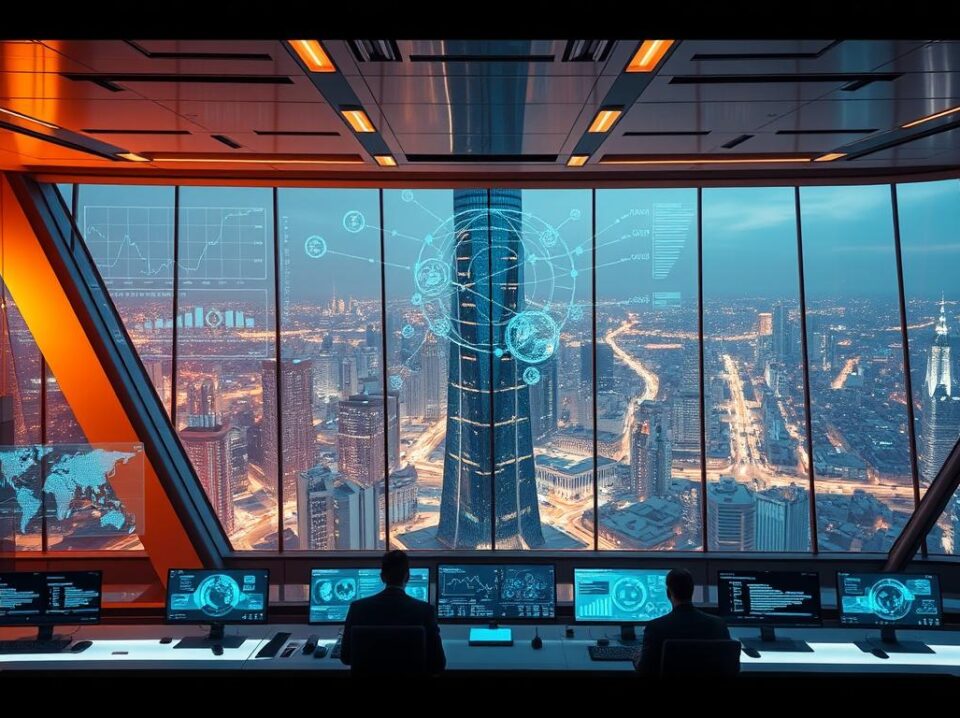Did you know that traditional monitoring systems are struggling to keep up with the complexity of modern systems? As technology gets more advanced, we need better ways to keep things running smoothly. Deep learning technologies are changing how we handle reliability, making systems that can spot and stop problems on their own.
The growth of artificial intelligence is moving us towards systems that work by themselves. These systems can look at lots of data, find patterns, and fix issues without needing a person to tell them what to do. Companies like nuaura.ai are leading this change, using Agentic AI to help businesses stay reliable without human help.
Key Takeaways
- Traditional monitoring systems are becoming outdated.
- Deep learning is revolutionizing reliability by enabling proactive failure prevention.
- Artificial intelligence is key to autonomous reliability solutions.
- Agentic AI is transforming the way businesses approach reliability.
- Autonomous systems can analyze vast amounts of data to predict and prevent failures.
The Limitations of Traditional Monitoring Systems
Traditional monitoring systems are mainly reactive, not proactive. This has led to a big move towards more advanced technologies. These systems have been key in reliability engineering, but their flaws are clear now.
Reactive Instead of Proactive Approaches
Traditional monitoring is often reactive. It waits to fix problems after they happen, not before. This way of working can cause downtime and lower system reliability.
Alert Fatigue and False Positives
Another big problem with traditional monitoring is alert fatigue. Too many alerts can overwhelm IT teams. This leads to false positives being ignored or missed.
Inability to Handle Complex Systems
Today’s systems are getting more complex. They have interconnected components and microservices. But, traditional monitoring systems find it hard to keep up with these complex infrastructures.
The Evolution of Reliability Engineering
Reliability engineering has changed a lot over time. As systems got more complex, new ways to keep them reliable were needed.
From Manual Checks to Automated Monitoring
Oldly, people did manual checks to find problems. But now, automated monitoring is key. It spots issues right away, cutting down on failures.
The Rise and Fall of Rules-Based Alerting
Rules-based alerting was seen as a fix for old methods. But it’s not enough for today’s systems. Chris Richardson, a top expert in microservices, said, “These systems are too rigid and often send out false alarms.”
“The complexity of modern systems demands a more sophisticated approach to reliability engineering.”
Why Traditional Monitoring Can’t Keep Up with Modern Infrastructure
Modern setups, like microservices and cloud-native, are tough for old monitoring to handle.
Microservices Complexity
Microservices need a smarter way to stay reliable. With many services working together, failures can spread fast. So, we need better methods to prevent this.
Cloud-Native Environments
Cloud-native systems change a lot, scaling up and down as needed. Old monitoring can’t keep up with this change. We need something that can adapt better.
Why Monitoring Is Dead: The Future of Reliability Belongs to Deep Learning
The future of reliability is changing with deep learning. Traditional monitoring is no longer enough. Systems today are too complex, and we need better solutions.
The Fundamental Shift in System Complexity
Modern systems are very complex and dynamic. This makes it hard for old monitoring methods to keep them reliable. Deep learning offers a solution by spotting patterns and anomalies in real-time. This helps prevent failures before they happen.
The Data Volume Problem
Today’s systems generate a lot of data. This is a big problem for old monitoring methods. Deep learning can handle this data well. It finds important insights that humans can’t see on their own.
Pattern Recognition Beyond Human Capability
Deep learning is great at finding complex patterns. It can spot early signs of failure and connections between different events.
Identifying Subtle Precursors to Failure
Deep learning looks at past data and current system metrics. It finds early signs of possible failures. This lets us fix problems before they get worse.
Correlating Seemingly Unrelated Events
Deep learning connects events from different parts of a system. This gives a complete picture of how well the system is working. It helps us make better plans for keeping things reliable.
| Traditional Monitoring | Deep Learning for Reliability |
|---|---|
| Reactive, rules-based | Proactive, pattern-based |
| Limited by data volume and complexity | Scalable, handles complex systems |
| Prone to alert fatigue and false positives | Reduces false positives through advanced pattern recognition |
Companies like nuaura.ai are leading the way with deep learning for reliability. They show how this technology can change the field.
How Deep Learning Transforms Reliability
Deep learning is changing reliability engineering a lot. It’s moving towards more proactive and predictive maintenance.
Predictive vs. Reactive Approaches
Old reliability engineering focuses on fixing problems after they happen. Deep learning brings a predictive approach. It finds problems before they cause issues.
This way, systems run better and less often stop. It makes them more reliable.
Anomaly Detection Without Explicit Rules
Deep learning models find odd behavior without specific rules. They look at data patterns to spot unusual signs. This helps prevent system failures.
Self-Improving Systems
Deep learning makes systems that get better over time. They learn from their experiences. This makes them better at predicting problems.
Learning from Past Incidents
Deep learning models study past problems to find patterns. This helps them suggest better ways to prevent issues.
Continuous Model Refinement
These models keep getting better as they adapt to new data. This keeps their predictive skills sharp.
Deep learning helps make reliability engineering better. It leads to more self-sufficient and proactive maintenance.
Agentic AI: The Next Frontier in Autonomous Reliability
Agentic AI is changing how we maintain systems. It uses artificial intelligence to fix problems before they start. This keeps complex systems running smoothly.
What Makes AI “Agentic”
Agentic AI can act on its own and make decisions fast. It looks at data in real-time, unlike older AI that follows set rules. This makes it better at handling complex systems.
How Agentic AI Proactively Maintains Systems
Agentic AI keeps systems running well in several ways:
- Predictive Maintenance: It looks at past and current data to know when to do maintenance. This cuts down on downtime and makes systems more reliable.
- Automated Root Cause Analysis: When a problem happens, Agentic AI finds the cause quickly. This lets it fix problems fast and right.
- Self-Healing Capabilities: Sometimes, Agentic AI can fix problems itself. This means less need for humans to step in, keeping systems running longer and saving money.
Automated Root Cause Analysis
Agentic AI’s ability to find problems fast is key. It helps fix issues quickly, keeping systems up and running.
Self-Healing Capabilities
Agentic AI’s self-healing is a big step forward. It fixes problems on its own, cutting down on the need for humans. This means systems are up more often and costs go down.
Real-World Applications of Agentic Reliability
Agentic AI is used in many fields like manufacturing, finance, and healthcare. It makes systems more reliable and saves money. Companies like nuaura.ai are leading the way with Agentic AI in predictive maintenance.
Case Study: How nuaura.ai Is Pioneering Deep Learning for Reliability
nuaura.ai is changing the game in reliability with its deep learning tech. It uses advanced AI to make systems more reliable. This sets a new benchmark in the field.
nuaura.ai’s Approach to Autonomous Reliability
nuaura.ai uses smart deep learning to spot and stop system failures before they happen. This is a big step up from old ways of just fixing problems after they occur.
Their Proprietary Deep Learning Architecture
nuaura.ai’s special deep learning design digs into system data to find signs of trouble. It’s great at catching oddities that could cause systems to crash.
Integration with Existing Infrastructure
One of the best things about nuaura.ai is how it fits right into what you already have. This means you can start using deep learning for reliability without spending a lot on new stuff.
Success Metrics and Improvements Over Traditional Monitoring
nuaura.ai’s deep learning tech shows its worth in several ways. It cuts down on false alarms, finds problems better, and keeps systems running longer. Here are some key improvements:
| Metric | Traditional Monitoring | nuaura.ai’s Deep Learning |
|---|---|---|
| False Positives | High | Low |
| Anomaly Detection | Limited | Advanced |
| System Uptime | Variable | High |
Customer Testimonials and Use Cases
Many companies have seen the benefits of nuaura.ai’s deep learning. As one customer said,
“nuaura.ai’s technology has significantly improved our system’s reliability and reduced downtime.”
This feedback shows how well nuaura.ai’s approach works for keeping systems running smoothly.
Challenges and Considerations When Adopting Deep Learning for Reliability
Using deep learning for reliability comes with its own set of challenges. As we move towards more self-reliant solutions, we face several key issues.
Data Quality and Quantity Requirements
Deep learning models need lots of good data to learn well. It’s important that this data is accurate, varied, and relevant for success in reliability.
Explainability vs. Performance Tradeoffs
Choosing between a model’s clarity and its performance is tough. Deep learning models perform well but can be hard to understand. This makes it hard to see why they make certain predictions.
Skills and Resources Needed
Deep learning for reliability needs special skills and resources. Companies must either train their own team or work with experts.
Building Internal Expertise
Creating your own team takes a lot of effort but gives you more control over the tech.
Partnering with Specialized Providers
Working with experts can speed up adoption. It also gives you access to the latest tech and best practices.
| Consideration | Description | Impact |
|---|---|---|
| Data Quality | High-quality data is essential for training effective deep learning models. | High |
| Explainability | The ability to understand and interpret model predictions. | Medium |
| Skills and Resources | Specialized skills and resources are required for deep learning adoption. | High |
Conclusion: Embracing the Future of Autonomous Reliability
The future of reliability is all about being autonomous. Deep learning and Agentic AI are key in changing how we maintain and improve systems. Traditional monitoring systems can’t keep up because they’re reactive and get tired of alerts.
Deep learning and Agentic AI are changing the game. They let us predict and act before problems happen. nuaura.ai is showing how autonomous reliability works in real life. Businesses can use these technologies to manage their systems better, cut downtime, and boost efficiency.
Looking ahead, the future of reliability is all about autonomous systems. With deep learning and AI, companies can run smoother, avoid issues, and reach new reliability heights. It’s time to jump on this bandwagon, and nuaura.ai is showing the way.
FAQ
What are the main limitations of traditional monitoring systems?
Traditional systems are slow to react and get overwhelmed by alerts. They can’t handle today’s complex systems. This makes deep learning a better choice.
How does deep learning improve reliability?
Deep learning changes how we keep systems running. It moves from reacting to predicting problems. It finds issues without rules and keeps getting better, making maintenance more effective.
What is Agentic AI, and how does it maintain systems?
Agentic AI is AI that keeps systems running well on its own. It finds and fixes problems automatically. This new way of maintaining systems is a big step forward.
What challenges are associated with adopting deep learning for reliability?
Starting with deep learning requires good data and the right skills. It’s about finding a balance between understanding how it works and its performance. You might need to learn new things or work with experts.
How does nuaura.ai’s approach to autonomous reliability work?
nuaura.ai uses deep learning to keep systems reliable without human help. Its special system works with many others. It shows better results than old ways, thanks to its deep learning tech.
What is the future of reliability according to the article?
The future is about systems that work on their own, thanks to deep learning and Agentic AI. This means better and more efficient reliability management.
Why can’t traditional monitoring keep up with modern infrastructure?
Old monitoring can’t handle today’s complex systems. It’s overwhelmed by too much data and can’t spot patterns like deep learning can.
What are the benefits of using deep learning for predictive maintenance?
Deep learning spots early signs of trouble and connects unrelated events. This makes maintenance better and cuts down on downtime.




